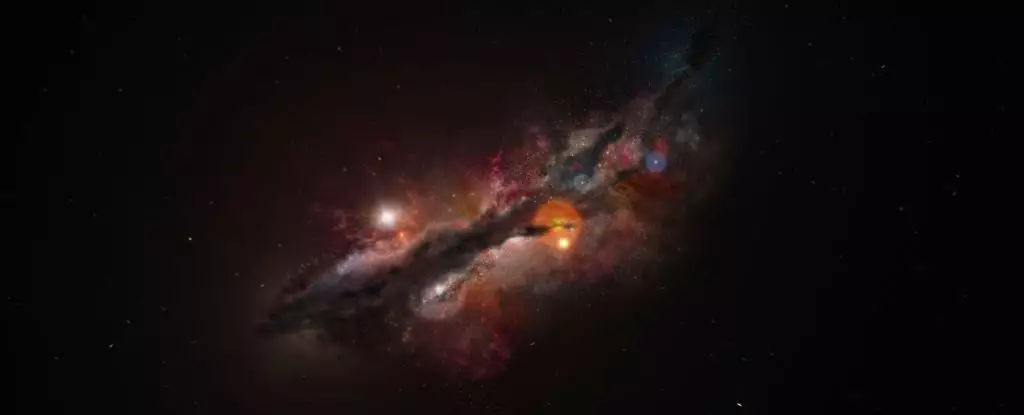In a groundbreaking revelation, scientists have identified a galaxy dating back to just 300 million years after the Big Bang, designated as JADES-GS-z14-0. This discovery defies previously held notions about the early universe, revealing a galaxy enriched with oxygen — a critical element that astounds researchers. The presence of oxygen this early in the cosmic timeline indicates an unexpected maturity, suggesting that the process of galactic formation and evolution unfolded much more rapidly than the scientific community previously believed. This finding has profound implications for our understanding of the universe’s infancy, challenging long-established theories in cosmology.
Challenges to Traditional Models of Cosmic Development
Historically, astronomers have perceived the formation of galaxies as a protracted process, requiring significant time for stars to evolve, exhaust their nuclear fuel, and enrich the surrounding space with heavier elements. It was commonly accepted that sufficient oxygen would not exist until later epochs, as the early universe was thought to be largely composed of hydrogen and helium. The discovery of JADES-GS-z14-0 complicates this narrative significantly, as not only does its existence challenge our current models — which struggle to explain such a bright and large galaxy at this time — but it also posits the idea that heavy elements began to form much sooner.
The astronomical community is now grappling with an intense reevaluation of galaxy formation timelines. As Sander Schouws, a cosmologist at Leiden Observatory, aptly noted, “It is like finding an adolescent where you would only expect babies.” This metaphor aptly encapsulates the essence of the find — a metaphorical leap towards an understanding of the universe’s rapid progress that we have yet to comprehend fully.
The Mechanisms Behind Element Creation
To fully grasp why the discovery of oxygen is so significant, it is essential to delve into the underlying processes that led to its formation. The universe’s inception at the Big Bang resulted in a primordial soup primarily composed of hydrogen and helium. Stellar evolution thereafter requires a series of complex phases: stars must form from collapsing gas clouds, ignite through fusion, and then explode as supernovae to disperse heavier elements throughout the cosmos.
The fact that JADES-GS-z14-0 showcases levels of heavy elements ten times higher than anticipated hints at a rapid and efficient formation process. This realization raises critical questions regarding the lifecycle of the stars that gave birth to this oxygen. Did these stars evolve and explode in an unexpectedly brief timeframe, thereby contributing to the rapid enrichment of the galaxy’s gases? Or do we have fundamental misconceptions about the nature and timeline of star formation in the early universe?
These questions compel scientists to rethink their assumptions about stellar life cycles and their consequences for galactic evolution. Stefano Carniani, an astrophysicist from Scuola Normale Superiore, expressed his surprise at these findings, stating that they evoke a whole new perspective on early galaxy evolution. This newfound understanding could redefine how we perceive the dynamics of the cosmos.
The Role of Advanced Observational Technologies
The monumental observation of JADES-GS-z14-0 was made possible through advanced technologies like the James Webb Space Telescope (JWST), the most powerful infrared space telescope deployed thus far. This state-of-the-art instrument utilizes its capabilities to detect the redshift from distant galaxies — an essential feature for studying the early universe. JWST’s precision has enabled astronomers to explore previously inaccessible corners of cosmic history, thereby revealing a universe in which galaxies appear to form and evolve more fluidly than was once thought possible.
In recent years, JWST has illuminated the existence of numerous large galaxies predating universally accepted timelines, offering a transformative perspective on the universe’s embryonic phase. With each new discovery, scientists piece together a more nuanced image of how galaxies emerged from the primordial chaos and evolved into the diverse structures we observe today.
Revisiting the Cosmic Timeline
As researchers continue to analyze these astonishing findings, it becomes increasingly imperative to reassess the cosmological timeline that contextualizes the evolution of galaxies. The implications of significantly earlier and rapid galactic growth challenge us to examine the assumptions and theories that have long been taught in academia. Excitingly, investigations into JADES-GS-z14-0 may pave the way for future studies that further unravel the mysteries of the universe, compelling cosmologists and astrophysicists alike to explore the question of what else awaits discovery in the dark voids of space.
This pioneering inquiry remains a part of a larger discussion, inviting continued research and exploration into the nature of our universe at its most nascent stages. As we delve deeper, one can only imagine what astonishing revelations lie ahead, potentially reshaping our understanding of cosmic evolution forever.

